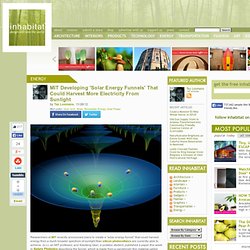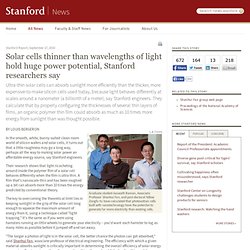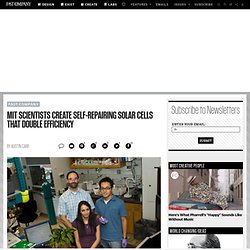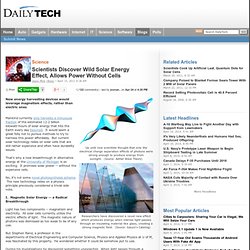

Solar Panel Using Human Hair. Did you know that melanin, the pigment in hair, is light sensitive and can be used as a conductor?

Well, that’s what an 18 year old in Nepal recently discovered, and is now using human hair to replace silicon in solar panels. Since the price of hair is considerably cheaper than silicon, this enterprising youth may have just found a breakthrough technology to help bring down the cost of solar and give thousands of people in developing nations access to affordable renewable energy. Malin Karki had already been trying to create affordable renewable energy from hydro currents for a few years, but the project had become too expensive. But then Karki, who attends school in Kathmandu, started reading a book by Stephan Hawking that discussed ways of creating static energy from hair. Solar-Powered Combustion Engine. While the idea of a solar powered car is attractive, the physical manifestation usually fails in both aesthetics and performance.

Most of the solar-powered vehicles we’ve featured in the past are either extremely tiny, using the sun to charge up their electric batteries, or extremely awkward, with solar panels sprouting out from every available surface. Liquid solar cells can be painted onto windows. Scientists at the University of Southern California have taken a big step towards the creation of solar cells in the form of a liquid ink that can be painted or printed onto clear surfaces.

Liquid nanocrystal solar cells are cheaper to fabricate than current single-crystal silicon wafer solar cells - but aren't nearly as efficient at converting sunlight to electricity. Previous efforts have involved attaching organic ligand molecules to the nanocrystals to keep them stable and to prevent them from sticking together. All well and good - except that these molecules also insulate the crystals, making the cells terrible at conducting electricity. Now, though, the USC team has discovered a synthetic ligand that not only works well at stabilizing nanocrystals, but actually builds tiny bridges connecting the nanocrystals to help transmit current. Photovoltaic Spray Paint. No, it's not a joke or a crazy awesome futuristic concept . It's real. Tata Steel Europe (formerly Corus) and Swansea University in Wales, UK are collaborating to develop a spray-on technology that would transform steel sheets into solar panels.
Earth and Industry says , The technology has significant applications since it is highly efficient even in diffused sunlight. Therefore, countries at higher latitudes or those with limited solar energy resource can generate significant amounts of solar-powered electricity with going for large-scale power plants. If extended, the technology can find its way to the automobile industry where photo-sensitive dyes can be applied to cars to generate electricity to split water into hydrogen and oxygen for fuel cells.
Imagine the applications of such a product. The power options could be limitless. And if you think the spray-on solar technology is years away from reality, think again. Stretchy Solar Cells Power "Super Skin" The "super skin" developed by Stanford University researcher Zhenan Bao is self-powering, using polymer solar cells to generate electricity.

The solar cells are not just flexible, but stretchable — they can be stretched up to 30 percent beyond their original length and snap back without any damage or loss of power. "With artificial skin, we can basically incorporate any function we desire," says Bao, a professor of chemical engineering, who presented her work on Feb. 20 at the AAAS annual meeting in Washington, D.C. Spin Cell Cones Electricity Low Cost. When V3Solar released information about their Spin Cell photovoltaic cones last year, the details already looked remarkably impressive; they have a smaller physical footprint than flat photovoltaic cells and the capacity to generate up to 20 times more energy for the same surface area.

Now Clean Technica has estimates for the Levelized Cost of Electricity from these cones, and—if V3Solar’s calculations are correct—the Spin Cell could be truly revolutionary. Citing a “conservative” estimate, V3Solar states that the cones can generate electricity for eight cents per kWh. Not only is that radically cheaper than current averages for solar PV electricity—28 cents per kWh—but it’s two-thirds of the cost of current retail electricity.
It’s important to note that V3Solar’s Spin Cell is still at the prototype stage, and one has to assume that some calculations will change as the product is refined and enters production. It all makes for an exciting prospect. . + V3Solar. Concentrating light. Solar technology is beginning to heat up, thanks to researchers at Rice’s Laboratory for Nanophotonics (LANP).

Concentrating light. 'Solar Energy Funnels' Harvest More From Sunlight. Researchers at MIT recently announced plans to create a “solar energy funnel” that could harvest energy from a much broader spectrum of sunlight than silicon photovoltaics are currently able to achieve.

Ju Li, an MIT professor, and Xiaoteng Qian, a postdoc student, published a paper this week in Nature Photonics describing the funnel, which is made from a vanishingly thin material called Molybdenum Disulfide (MoS2). Li and Qian’s solar energy funnel is much more sophisticated than your household funnel. The device is created by using a microscopic needle to poke a tiny hole in a thin film of MoS2 that is only a single molecule thick.
This indents the surface and creates a funnel-like shape. The pressure exerted by the needle creates elastic strain, which is highest at the film’s center where it’s poked. Thinner than wavelengths of light holds protons more. L.A.

Cicero Graduate student Aaswath Raman, Associate Professor Shanhui Fan, and post doctoral fellow Zongfu Yu have calculated that photovoltaic cells built with nanotechnology have the potential to generate far more electricity than existing cells. In the smooth, white, bunny-suited clean-room world of silicon wafers and solar cells, it turns out that a little roughness may go a long way, perhaps all the way to making solar power an affordable energy source, say Stanford engineers. Self-Repairing Solar Cells. Solar power is inefficient.

Whenever those plains of panels are laid out, the sunlight they convert into stored energy also degrades their effectiveness. With each day the panels spend smoldering under the sun, they become more unreliable in harvesting the rays. For many new systems, designed for lower cost and flexibility, degradation is a huge issue: In just 60 hours, efficiency can sometimes plummet as much as 90%. To fix that problem, researchers from MIT turned to some excellent harvesters of sunlight for inspiration: plants. Chemical engineering professor Michael Strano recently had a eureka-moment while reading about plant biology. Magmetique properties of light. Up until now scientists thought that only the electrical charge separation effects of photons were strong enough to produce energy from sunlight.

Organic solar Power. The Millennium Technology Prize trophy, named "Peak," features a silicon tip. Back in 1991, Professor Michael Graetzel from the Lausanne Polytechnic invented what's now called the Graetzel Cell, a non-photovoltaic solar cell made of a layer of titanium dioxide, glass and a dye from fruit that absorbs sunlight like the chlorophyll in green leaves. The Swiss professor has since continued developing this "artificial photosynthesis" without the need for an expensive manufacturing process, and last week he won the million dollar Millennium Technology Award.
Absorbs from infrared spectrum. By Stephen C. WebsterThursday, June 21, 2012 14:51 EDT A scientific breakthrough by researchers at the Massachusetts Institute of Technology (MIT) has produced a new type solar cell capable of absorbing energy from the infrared spectrum, where about 40 percent of the energy in sunlight exists. All prior solar cells ignored the infrared spectrum for energy stored in visible light, but the new cell uses purified carbon fibers converted into microscopic tube-like structures called nanotubes to capture the hidden power.
Details of the new cell were published in the latest edition of the scientific journal Advanced Materials. A bonus: Researchers said that because the cells are transparent, they could one day be laid on top of currently existing solar arrays, turning the less-efficient and more common photovoltaic cells into hybrids capable of much greater energy output. Carbon nanotubes have been at the forefront of renewable energy research for several years now. Stephen C. Stephen C. Absorbs the entire solar spectrum. It's about damn time, don't you think? Scientists at Lawrence Berkeley National Laboratory announced Wednesday that they have been able to confirm a new high-efficiency solar cell design that utilizes nearly the entire solar spectrum. Translation: They figured out a way to make solar panels generate electricity in the dark. CleanTechnica says , In earlier trials, the researchers used different alloys that achieved full spectrum responses but involved very high production costs.
The advantage of gallium arsenide nitride is that it is very similar to a conventional semiconductor, gallium arsenide, and it can be produced with a commonly used fabrication method involving chemical vapor deposition. The Lawrence Berkeley breakthrough represents just one path to increasing the efficiency and lowering the cost of solar cells. In the meantime, you could just turn any metal surface into solar panels with photovoltaic spray paint .